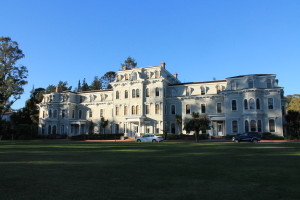
In light of recent uncertainty surrounding the future of the Mills dance department, the release of Mills dance professor and alumna Molissa Fenley’s book is as timely as it is exciting for her students and colleagues on campus.
Fenley’s new book, “Rhythm Field,” is a look into her 40 year career in the field of postmodern dance from the perspectives of colleagues, friends, admirers and fellow artists across disciplines. After receiving a Guggenheim Grant in 2008, she contacted fellow Mills Professor Ann Murphy to take on the role of co-editor, and began collecting essays from artists around the world, compiling an anthology of perspectives on her performance and artistry.
“She had in mind a book of artists writing about her as an artist,” said Murphy, a writer and professor of dance at Mills since 2007. “What I love about how this evolved was that each contributor has a different angle on Molissa.”
Since 1977, Fenley has been working, performing and choreographing, continuously creating works that are studied by students of dance around the world. Her performance aesthetic is deeply informed by both postmodernism and addressing issues of global justice through movement and metaphor. Fenley’s works include performances that are as much exercises in physical endurance as they are in grace, from dancing in slow motion to balancing large props during the entirety of her act.

“It’s Olympian in its physical challenge,” Murphy said of Fenley’s choreography. “No one does [what she does].”
Currently Fenley splits her time between Oakland and New York, teaching at Mills during spring and performing with her dance company for the rest of the year. After gaining critical success in the years after her graduation, Fenley was invited back to Mills to teach in 1999 by trustee and friend Joan Danforth, who donated a grant to the dance department to help fund the hire.
Zackary Forcum, second year dance MFA student, recalls working with Fenley as a formative experience in his dance education.
“To have a legend like Molissa Fenley on this campus, an artist who works all around the world…she brings a special excitement,” Forcum said. “I wish Mo would teach even more classes, to be honest! I wish more people would get to experience just what a wonderful person she is and what a wonderful presence she is.”
Fenley was raised from the age of six in Ibadan, Nigeria, the child of an agriculturalist for the US Agency of International Development. Her experience growing up in Nigeria became formative to her style, dovetailing her training in Western dance at Mills with a deep interest in and respect for the kinesthetic values of West African dance and music. She arrived at Mills in 1971 at 16-years-old, with intentions of being a dance therapist, but no education in the field beyond that which she observed during her upbringing in Africa.
“I was [at Mills] for all four years, and managed to get trained from being a person who had absolutely no dance training at all to a person who, immediately from graduation, moved to New York to become a dance choreographer,” Fenley said.
Senior dance major Mackenzie Pierson was so inspired by her time with Fenley that she is writing her thesis about Fenley’s choreographic process.
“She’s so prolific,” Pierson said. “There’s not very many female choreographers who have created as much work as she has.”
Pierson hopes that studying Fenley’s work will provide a toolkit for her and other dancers and choreographers to follow in her footsteps.
“It’s very playful,” Pierson said of Fenley’s choreography and teaching style. “But serious! She takes herself very seriously and her work very seriously, so it’s this amazing combination of super playful and free and super serious and really hardworking.”
Fenley feels that dance is not just an art form, but a way of thinking and understanding oneself as a whole human being.
“Anyone who does a dance major, whether or not they decide to dance later on in life, they have a really good source of information of how to live a life,” Fenley said.

Fenley’s innovation and work ethic have propelled her to a level of success that few women in her field are ever able to reach, and her presence on a campus dedicated to the success and empowerment of women is already leaving a profound effect on the next generation of young artists. Her book is a celebration of the greatest works of the past 40 years of her life, but even more exciting are the volumes of her own work and work inspired by her teachings that are surely still yet to come.



